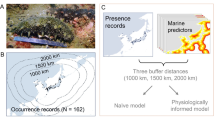Abstract
In many ecological research studies, abundance data are skewed and contain more zeros than might be expected. Often, the aim is to model abundance in terms of covariates, and to estimate expected abundance for a given set of covariate values. An approach that has been advocated recently involves the use of a conditional model. This allows one to separately model presence and abundance given presence, which should lead to a more complete understanding as to how the covariates influence abundance. The focus of this article is on the calculation of confidence intervals for expected abundance given particular values of the covariates. The standard Wald confidence interval is symmetric, and therefore unlikely to be of much use for skewed data, where reliable confidence intervals for abundance will generally be asymmetric. The purpose of this article is to show how to calculate a profile likelihood confidence interval for expected abundance using a conditional model.
Similar content being viewed by others
References
Barry, S. C., and Welsh, A. H. (2002), “Generalized Additive Modelling and Zero Inflated Count Data,” Ecological Modelling, 157, 179–188.
Brown, L. D., Cai, T., and DasGupta, A. (2003), “Interval Estimation in Exponential Families,” Statistica Sinica, 13, 19–49.
Cox, D. R., and Hinkley, D. V. (1974), Theoretical Statistics, London: Chapman and Hall.
Dobbie, M. J., and Welsh, A. H. (2001), “Modelling Correlated Zero-Inflated Count Data,” Australian and New Zealand Journal of Statistics, 43, 431–444.
Fletcher, D. J., MacKenzie, D. I., and Villouta, E. (2005), “Modelling Skewed Data with Many Zeros: A Simple Approach Combining Ordinary and Logistic Regression,” Environmental and Ecological Statistics, 12, 45–54.
Johnson, N.L., Kemp, A.W., and Kotz, S. (2005), Univariate Discrete Distributions (3rd ed.), New York: Wiley.
Khuri, A.I. (1993), Advanced Calculus with Applications in Statistics, New York: Wiley.
Lambert, D. (1992), “Zero-Inflated Poisson Regression, With an Application to Defects in Manufacturing,” Technometrics, 34, 1–14.
Martin, T.G., Wintle, B.A., Rhodes, J. R., Kuhnert, P.M., Field, S. A., Low-Choy, S. J., Tyre, A. J., and Possingham, H. P. (2005), “Zero Tolerance Ecology: Improving Ecological Inference by Modelling the Source of Zero Observations,” Ecology Letters, 8, 1235–1246.
Stephenson, G. (1961), Mathematical Methods for Science Students, London: Longmans.
Venzon, D. J., and Moolgavkar, S. H. (1988), “A Method for Computing Profile-Likelihood-Based Confidence Intervals,” Applied Statistics, 37, 87–94.
Welsh, A. H., Cunningham, R. B., Donnelly, C. F., and Lindenmayer, D. B. (1996), “Modelling the Abundance of Rare Species: Statistical Models for Counts With Extra Zeros,” Ecological Modelling, 88, 297–308.
Author information
Authors and Affiliations
Corresponding author
Rights and permissions
About this article
Cite this article
Fletcher, D., Faddy, M. Confidence intervals for expected abundance of rare species. JABES 12, 315–324 (2007). https://doi.org/10.1198/108571107X229322
Received:
Revised:
Issue Date:
DOI: https://doi.org/10.1198/108571107X229322




